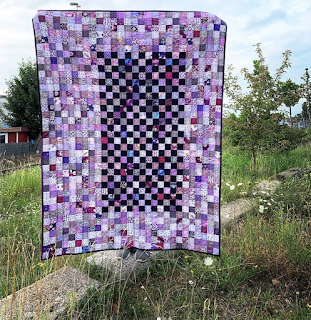This Jack and Jill is made from my 2 1/2 inch squares bins and those exchanged with my quilt group's quarantine round robin exchange.
84 by 72 inches
You can make the quilt any size you want. These directions are for the 72 by 84 inch quilt top I made. I did include many objects and kept them oriented the same way but that is not necessary.
I sewed it in seven 6-row panels to help reduce the stress on the fabrics to sew it as 42 individual rows. Also, sewing individual rows onto a mother-ship really irritates me.
Below is my process.
Cutting
Prints:
Cut lots of 2 1/2 inch scrap squares. For this quilt it took 1008.
Solid:
Cut lots of 2 1/2 by 4 1/2 inch rectangles. For this quilt it took 245.
Cut a few 2 1/2 inch squares. For this quilt it was 14
(note, numbers are by estimating and I may be off a few.)
Unit piecing
Piece four scrap squares into 224 units, sew a solid rectangle onto the end of each.
Sew a square onto the end of seven of them.
DO NOT PRESS YET
Remaining scraps and solids will be used to help make the rows stagger
Assembly
Sew 210 of the units with the rectangles into 5 unit rows.
DO NOT PRESS YET
Lay out six of these into rows. You will use the remaining units and squares and rectangles to bring your rows to 72 inches. This is six units long but most of the rows have the final unit split to the beginning and end of the row.
Row 1: five units with solid leading, add one unit to the end PRESS to left
Row 2: five units with added one scrap leading and a rectangle and three scraps ending PRESS to right
Row 3: five units with added two scraps leading and a rectangle and two scraps ending PRESS to left
Row 4: five units with added three scraps leading and a rectangle and one scrap ending PRESS to right
Row 5: five units with scraps leading, add one unit to the end PRESS to the left
Row 6: five units with a solid square and four scraps leading, one solid square ending PRESS to the right
 |
| Left side of panel |
 |
| Right side of panel |
Assemble the six rows, pressing seams up as each row is added.
Make seven panels.
Assemble the 7 panels into the top
All seams will nest
My design, use at your pleasure.



















































